
Features
Structural
Training
Forcible Entry: Choosing, using and maintaining the irons
Choosing, using and maintaining the irons
December 11, 2007
By Andrew Brassard
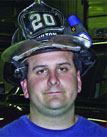 For the better part of 60 years, the irons have been the staple for most of the fire departments in North America when it comes to forcible entry. The irons usually consist of an eight-pound flat-headed axe (also known as a forcible entry axe) and a 30-inch halligan bar. These two tools can marry together (see photo 1) to be easily carried in one arm. When these two tools are carried together it gives the user the options of prying, cutting and striking.
For the better part of 60 years, the irons have been the staple for most of the fire departments in North America when it comes to forcible entry. The irons usually consist of an eight-pound flat-headed axe (also known as a forcible entry axe) and a 30-inch halligan bar. These two tools can marry together (see photo 1) to be easily carried in one arm. When these two tools are carried together it gives the user the options of prying, cutting and striking.
In the hands of a well-trained firefighter, there is little in the way of forcible entry that cannot be accomplished with these two tools. Here, we look at the irons: specifically, how to choose the appropriate tools, how to make the irons more user friendly and how to maintain your tools.
The halligan bar
The halligan bar was invented in the 1940s by Hugh Halligan of FDNY and since then has been the most popular forcible-entry tool in the fire service. Since the ’40s, little has changed when it comes to the design of the halligan but now, in our commercialized world, there seems to be a new company making halligan bars (or facsimiles) every year. But are all halligans the same? No (see photo 2). When selecting a proper halligan, there are a couple of things that firefighters should consider. The halligan should be made from one solid piece of drop forged steel (see photo 2, bottom). Some halligans on the market are made from three separate pieces of steel that are attached by a set screw or tack weld and are susceptible to failure when being hit with the striking tool (photo 2, top). The adz should be six to eight inches long and bevelled slightly toward the fork end. The fork should also be six to eight inches in length and bevelled slightly towards the adz side of the tool. Three-piece tools are usually much heavier than their forged counterparts and the fork end is usually too fat to be easily driven between a door and a jamb.
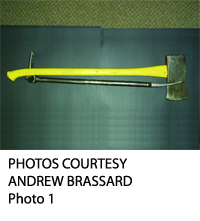 Striking tools
Striking tools
The two most common striking tools in the fire service are the sledgehammer and the flat-headed axe. When selecting a flat-headed axe, ensure that the axe is heavy enough for the job at hand but not so overly heavy that it causes early fatigue in the firefighter swinging the tool. The eight-pound flat-headed axe meets these criteria.
When marrying the flat-head axe and the halligan together, the fork can be placed over the blade of the axe and the adz/pike end will butt up against the shaft of the axe. Many departments use straps to keep these two tools together; some of these straps can be very simple or quite elaborate with built-in shoulder straps and other fancy gadgets that all glow in the dark. The problem with straps is that they usually don’t hold the tools together very well or can be difficult to undo in zero visibility with firefighting gloves on. A better solution is use a Dremel grinder to notch out a very small path for the halligan forks to go through (see photo 3). After the notch is created, simply place the halligan forks into the notch and then give the two tools a quick hit into the ground, setting the halligan onto the axe. After the halligan is set, the tools are “locked” together, can easily be carried with one hand and will not fall apart (see photo 4). To get the tools apart, simply hit the butt end of the axe shaft into the floor.
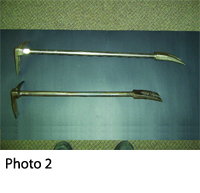 The sledgehammer is another favourite striking tool of firefighters. The sledgehammer should be at least eight pounds for effective striking. The biggest problem with the sledgehammer is that it does not marry well with the halligan. However, this is easily corrected by welding a bracket onto the top of the sledgehammer for the adz of the halligan to slide through (see photo 5). This will help hold the position of the halligan but will not keep the two from falling apart. To keep the two tools securely together, a marrying strap will need to be used (see photo 6).
The sledgehammer is another favourite striking tool of firefighters. The sledgehammer should be at least eight pounds for effective striking. The biggest problem with the sledgehammer is that it does not marry well with the halligan. However, this is easily corrected by welding a bracket onto the top of the sledgehammer for the adz of the halligan to slide through (see photo 5). This will help hold the position of the halligan but will not keep the two from falling apart. To keep the two tools securely together, a marrying strap will need to be used (see photo 6).
In my opinion, the flat-headed axe is a superior tool and gives the user far more options when it comes to forcible entry. The sledgehammer is single-functioning tool and can have its limitations in forcible entry.
Note: Be sure to check with your department before modifying any tools.
Tool maintenance
One sure sign that a fire department does not take forcible-entry operations seriously is damaged forcible-entry tools. I have seen tools that are rusted, chipped, cracked, broken, and, in some cases, missing. The shape of the tools says a lot about the company using them; rusted and unkempt tools can be dangerous and show a lack of pride and ownership. Forcible-entry tools need to be treated like any other life-saving tool on the truck; they need to be cared for and checked often to ensure they are ready for action. Why is this so important? Because when the tools are not cared for they do not work to their full potential and can let you down when you need them the most. Here are some simple tips for maintaining and caring for your forcible-entry tools:
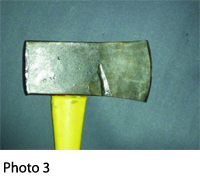 1. Pull each of forcible entry tool off the truck and inspect it; this should be done after each use and at the start of each tour for career fire departments, on each training night for volunteer departments. Look for:
1. Pull each of forcible entry tool off the truck and inspect it; this should be done after each use and at the start of each tour for career fire departments, on each training night for volunteer departments. Look for:
• Chips, nicks, burs, and sharpness of cutting surfaces;
• Rust;
• Cracks or dents on fibreglass or wooden handles;
• Burs or nicks on striking surfaces;
• Signs that axe heads are secure.
All problems with the metal parts of tools can be corrected using a bench grinder with a wire wheel and a hand file.
2. Tools should be kept clear of paint because paint can hide cracks and signs of weakness in the metal. Also, paint chips can flake off and become projectiles that can cause eye injuries.
3. Cutting edges need to be kept sharp but not razor sharp; edges that are too sharp tend to chip or dimple very easily. When sharpening axes or halligans do not use a bench grinder because it will grind down the metal very quickly and may thin the cutting edge too much. To sharpen the axe, simply use a hand file to get a nice cutting edge.
4. Metal surfaces can be covered with a light coat of grease or oil to prevent rusting. If using oil or grease on the metal surfaces, do not put any on the striking surfaces to avoid the risk of tools slipping when they strike each other.
These are simple things that departments should do to select and care for the proper forcible-entry tools and ensure they are battle ready.
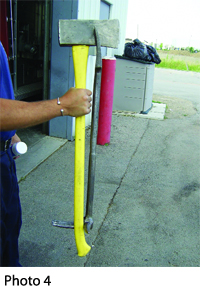
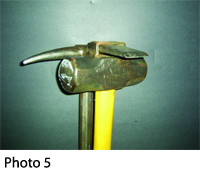
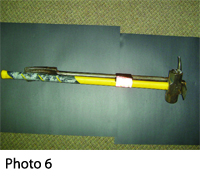
Andrew Brassard is a career firefighter with the Milton Fire Department. In 2006 he was one of two Milton firefighters awarded the Ontario Medal for Firefighter Bravery and the MSA Fireslayer of the Year Award for bravery. He owns Phoenix Fire Service Training and teaches forcible entry in Ontario. He can be reached at andrew.brassard@milton.ca .
Print this page